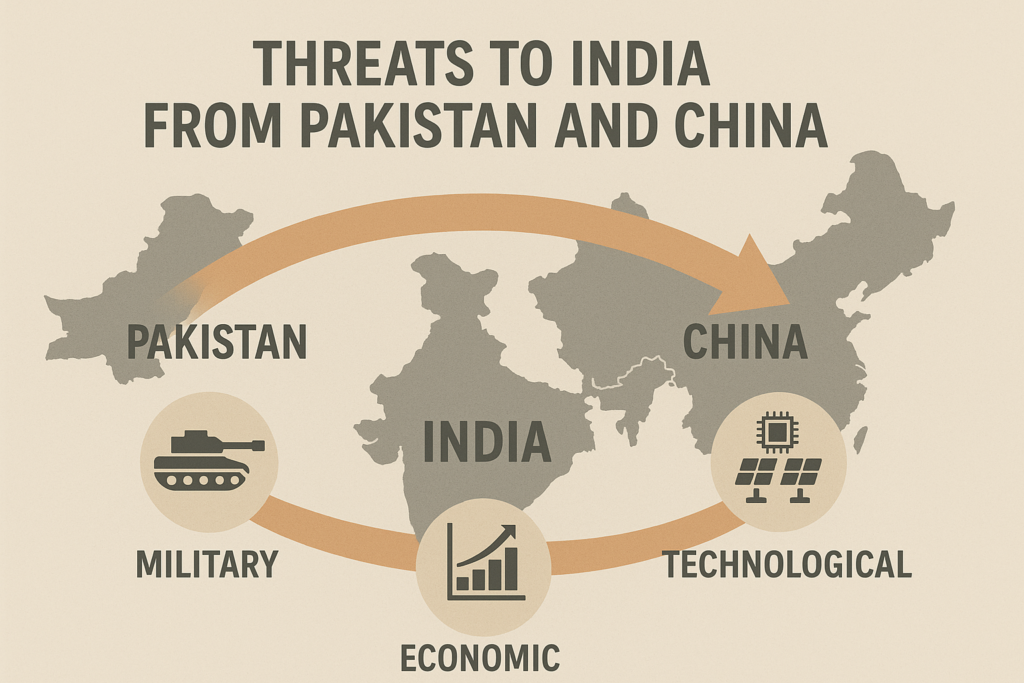
- India’s exemplary performance in Operation Sindoor posed an existential threat to Pakistan, not through nuclear force, but by exposing the military’s weakness against its primary enemy.
- China invested heavily in asymmetric weapon systems; China perfected the Anti-Access (A2AD) military strategy.
- India faces a grim reality: two major global powers show little understanding of its challenges, one guided by strategic calculation, the other by personalistic, revolutionary leadership.
A Moving Target
After having faced the humiliating defeat at the hands of the Indian Military in 1971, Pakistan quickly regrouped and decided to move towards attaining nuclear weapons, which drastically shifted the balance of power in its favour. It was also the period of India’s greatest vulnerability, as noted by K. Subrahmanyam, in the 1979 Joint Intelligence Committee, that Pakistan had come to possess nuclear capability. (Joshi, 2022). From the late 70s to the late 80s, it represented the most vulnerable period of India’s history. The lesson the Government drew was not very different from what the military must have already felt. Though as a matter of policy, it started under a civilian government of Bhutto, but it was executed in military-ruled governments. Defeat is not extinction because all defeats have the impetus within them that propels them toward victory tomorrow. Victory, on the other hand, is cursed with complacency.
Shekhar Gupta, in one of his coverages of the Operation, speaks of the seven-year stint of terrorism, essentially making the case that crises have been followed by more terrorist attacks rather than a process for stability. (Gupta). Under general conditions of state-to-state relationships, crises often make them acutely aware of the fragility of a supposed balance taken for granted. 26/11 and the attacks of 2006, 2010, 2012, 2016, and 2019, all of them have come at times when it was adjudged that the relationship has now attained stability for normal relations to be initiated. In that sense, the stupendous success of Operation Sindoor has a more sobering dimension that also needs exploration. Rajesh Rajgopalan, in an article he wrote on the day of the operation, contended that the operation lacked the deterrent effect because, he said, it did not target the heads that controlled the terrorists, i.e., the Pakistani military (Rajgopalan, 2024).
One could disagree with the professor’s assessment insofar as one contends that the problem of terrorism has seeped so much into Pakistan’s system that deterrence in a single act is problematic. Moreover, a distinction drawn between the military of Pakistan and terrorists is in reality a forceful distinction, but it does not address another reality of Pakistan. What is often joked as “Pakistani military having a country” has a deeper structural truth, it could be argued that the layer of protection to the state in case of any other country is if accorded by the military then in the case of Pakistan it is the terrorist organizations that provide that layer of protection to the military. Military rules, not by mandate, but it is common knowledge that it is the shot caller, and it derives legitimacy from its perception of being professional and infallible. What India exhibited through its exemplary performance in defence through Operation Sindoor is tantamount to being considered an existential threat in Pakistan, not because India threatened it with nuclear weapons, which it did not, but because the military’s weakness vis-à-vis its only primary existential enemy was for everyone there to see. There will be a strategic shift that will be attempted without a doubt by Pakistan to bring back some level of balance in what seemed to be a one-sided affair.
Diplomacy Under Siege
The geopolitics of the last five years have been such that it seemed that the consensus was closing in on Pakistan being considered a pariah state, especially after America’s extrication from Afghanistan. But the way Pakistan found outside support turned those assumptions on their heads. In one way, Indian diplomacy that was directed at isolating Pakistan by actively bringing a consensus on terrorism faced its abject limitations. An institution like the IMF, or for that matter India’s strategic partner, the United States, found no moral reprehension in giving tacit if not outright assistance to Pakistan. It has been no secret that China has been the primary bulwark of the Pakistani defence system, not only that, but also the use of Chinese navigation systems by the terrorists, who must have had access to the Chinese satellite from the topmost decision-making authorities of China. Yet in the Chinese Foreign Ministry read out of Wang Yi’s telephonic conversation with India’s NSA had mention of the term “terrorism” regarding Op. Sindoor, but Indian partners, on the other hand, tried their best to de-link the Indian response from the terrorism of Pakistan. The rather inexplicable Trumpian intervention was so incredibly uninformed that it alone has the potential to roll back progress made in the Indo-US relationship in the last two decades.
However, hyphenation as a matter of policy is not likely to be pursued by the White House, if the establishment of the USA that has persisted despite Donald Trump is to be relied on. The bipartisan consensus that has been attained after much tribulation on China in Washington, of which the Indo-Pacific strategy is fundamental, and India is, if not, the most fundamental to that strategy. India is face to face with a grim reality, where two of the major players in the world have exhibited very limited understanding of India’s predicaments. If one is driven by strategic design, then the other is led by an overly personalistic revolutionary leadership.
In the battleground Pakistani Military, if it had very little to show for, then it was more or less compensated by the modest international support India could garner for its legitimate actions in response. Army Chief Munir’s public pronouncements before the Pahalgam attack, where he vilified the Hindus and emphatically consolidated the military’s role around the two-nation theory. Something more often than not expected only of politicians, but it suggests something more sinister. The events as they have transpired must have intensified the very process Munir is attempting; a totalitarian control of government eliminating the role of civilian leadership to a point of inoperability, but perhaps ritualistic. Doubling down on this renewed Islamist uprising against India, the military, in all probability, will systematically put the political wheels in motion for a defence budget Pakistan had in the 1960s-75, more than 65% of the total budgets each year.
For the military, it makes sense to keep the political scenario as predictable as possible, which has also been its strategy, as experimentation can lead to surprises like Imran Khan, who was neutralised by the establishment in a time when civic dissatisfaction had the most limited space. Certain parties like Markazi Muslim League, which for all practical effects and purposes is the political wing of Hafiz Saeed, could be utilised by the military to let them take advantage of the renewed Islamist anti-India sentiments, most probably as a bargaining chip to attain a greater level of subservience from the civilian leadership.
Lessons From Beijing
In the 1990s, the Chinese Communist Party sensed the correlation of forces not to be in their favour, which is often cited as Deng’s famous words, “Tang Guang Yang Hui,” meaning hide your strength and bide your time. In response to the unipolar moment in the history of the United States of America, being the power that can bring overwhelming force upon any region. Deng’s statement was not only a philosophical aphorism about feeling the stone while crossing the river, but it also had tremendous operational value, which seems to have attained its objectives. China invested heavily in asymmetric weapon systems; China perfected the Anti-Access (A2AD) military strategy. It clandestinely acquired its first-ever aircraft carrier so as not to raise eyebrows in Washington, and also to acquire something that has already been built, which is always cheaper.
Peter Thiel, the famous philosopher-investor, has stressed that creating something truly new (“going from zero to one”) is fundamentally more valuable and difficult than merely copying or scaling existing things (“going from one to ‘n’”). In that sense, Chinese superiority has come from a great part of its replication of the existing, and where it has created new by large-scale investment, it is in the domain of artificial intelligence, which has civilian as well as military applications. Reservations regarding “one to ‘n’” are best taken with caution, because replication may seem like it is falsification of some sort, but it has foundational incongruities which also deserve to be addressed. War in and of itself is a Western foundation based on challenging the moral hesitations associated with violence. In that sense, moral arguments against the appropriation of instruments of war are on shaky grounds. Private property as an inviolable right set out in John Locke’s work has the fundamental assumption that the property acquired was not acquired through stealing.
Furthermore, replication could often be downplayed, but it can work in profound ways, sometimes even outperforming what could be considered the original. Chinese diplomacy through the use of its wolf-warrior methods and consolidating its modus vivendi with the Western World, based on the “Century of Humiliation,” has been successful in its operations of appropriation of technological know-how to build further strength in its de-coupling process from the West. Economics has been fundamental to the security of China, as laid down most categorically in its latest white paper on national security (China’s National Security in the New Era).
(The analysis will be continued in a concluding part.)
References:
- (n.d.). China’s National Security in the New Era. The State Council Information Office, People’s Republic of China. Retrieved from http://english.scio.gov.cn/whitepapers/2025-05/13/content_117871660.html
- Gupta, S. (n.d.). How can India cure Pakistan’s 7-year terror itch? The Print. YouTube. Retrieved from https://youtu.be/2DRCi2ipXB0?si=8Hl35aTPg7pMSh60
- Joshi, Y. (2022). Hubris, Biases, and Overlearning: A Historical Analysis of How India Missed Pakistan’s Nuclear Coup. Observer Research Foundation.
- Rajgopalan, R. (2024, May 07). Operation Sindoor aimed at the hands that wield the gun, not the brains that control the hand. The Print. Retrieved from https://theprint.in/opinion/operation-sindoor-aimed-at-hands-that-wield-the-gun-not-brains-that-control-the-hand/2617720/
- Taneja, K. (n.d.). Operation Sindoor: There’s A Unique ‘ISIS’ History To Pakistan’s Drones. NDTV. Retrieved from https://www.ndtv.com/opinion/operation-sindoor-theres-a-unique-isis-history-to-pakistans-drone-warfare-8410541
Sushruta Batsya holds an MA in International Relations from the Central University of Punjab. A passionate writer on economics, finance, security, and international affairs, he has contributed to esteemed publications like The Assam Tribune. He served as a Junior Research Analyst at the Institute for Conflict Research and Resolution for over two years, focusing on Northeast India.
